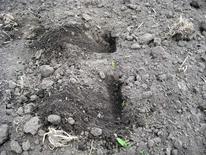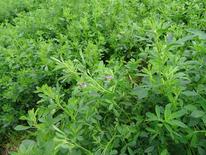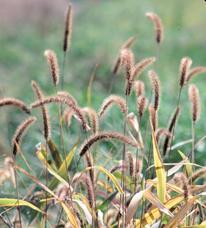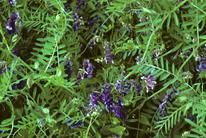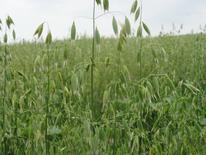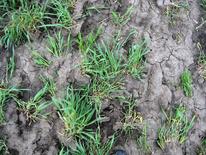By Jill Sackett Eberhart
Edited by Steve Simmons, Kristine Moncada, Craig Sheaffer, Gigi DiGiacomo and Nicole Tautges
“We’ve got a problem, Dirk*,” stated farm hand Al Detert. “The corn in the south field is just not germinating. In some spots, not only is the plant not there, but I can’t find the seed, either. That field has been a pain all spring. First it was the cover crop not dying and now the corn’s not growing. What are we going to do?”
Dirk Peterson’s south central Minnesota family farm was established in 1872. Over the years, the farm had been managed by various family members and had seen numerous crop rotations and livestock operations come and go. When Dirk himself began farming the land in 1988, he raised conventional corn and soybean and also feeder pigs. The 1990s were less than ideal, however. In 1999, a farm auction was held and, in 2001, Dirk made the decision to stop farming and rented the farm to a neighbor for alfalfa production.
Even though he was no longer farming, Dirk continued with agriculture. He began working for an independent corn and soybean seed testing program, which took him throughout the western portion of the Corn Belt. He continued to keep an eye on the family farm and started taking a closer look at organic production. Even though much of Dirk’s time was focused on hybrid and variety seed plots, he still made time to learn what he could about organic production by attending events, such as the University of Minnesota Southwest Research and Outreach Center’s Annual Organic Crops Day. He also made a point to talk to experienced organic farmers from around Minnesota.
As time went on, Dirk began to miss farming. He soon realized that his work with the seed testing program could help to finance the transition to organic crop production on his farm and that the current crop of alfalfa being raised there by his neighbor offered an ideal opportunity to transition. In 2004, Dirk harvested the first transitioning organic acres on his family farm. As the organic transition process slowly unfolded, Dirk was seeing organic corn yields averaging 165 to 185 bushels per acre in the first few years after the alfalfa.
By 2014, Dirk Peterson was a seasoned organic farmer with 360 acres of certified organic land, 280 of which he owned and 80 that he rented. He raised organic corn, soybean, oats, winter wheat, and canning peas. Corn averaged around 145 bushels per acre and made up the majority of Dirk’s crops. Since 2008, he had also been the owner and manager of an independent seed-testing program in Minnesota. One full-time employee, Al Detert, joined him at that time and became his “right-hand man.”
Emerging Challenges
As time went by, Dirk Peterson saw his organic corn yields drop and weed pressure increase in certain areas of the farm, particularly from foxtail. He’d seen soybean aphids hinder his organic soybean production and had done his best to get contracts for early harvested crops like oats or canning peas. He’d learned the ins and outs of the National Organic Program (NOP), particularly when it came to inputs and rotation. And, he’d also done what he could to learn about cover crops; Dirk initially became interested in them as a way to increase fertility and decrease weed pressure.
Cover crops have the potential, when managed correctly, to be quite beneficial when included in a crop rotation, whether conventional or organic. Depending on the species or mixture chosen, cover crops can decrease erosion, weed pressure, nutrient loss, and compaction; increase organic matter, water infiltration, and nutrient cycling; and serve as alternative forage. The use of cover crops can be risky, especially during wet springs or droughty falls. Crop insurance also has specific rules regarding summer/fall establishment and spring termination.
Dirk and Al first started using cover crops in 2009. Hairy vetch was planted after organic winter wheat in late summer of that year. Spring of 2010 found the hairy vetch coming through its winter dormancy in such a vigorous way it made the use of tillage as the termination method a bit tricky. Spring termination went moderately well, but the hairy vetch roots had a tendency to ball up around the field cultivator. There was still quite a lot of residue later in the spring and Dirk felt that this inhibited some of the corn germination and made row cultivation for weed management difficult.
Trials with Cover Crops
In fall of 2010, Dirk joined a bi-state cover crop program administered by two non-profits and managed by an Extension Educator from the University of Minnesota. That year he used a cover crop of mostly oil seed radish planted in mid-August after organic oats. Annual ryegrass was also mixed in with the oil seed radish on the headlands and there was one strip of Austrian winter pea and one strip of hairy vetch. Very little of the annual ryegrass or hairy vetch overwintered that year; therefore, little termination was needed in the spring of 2011.
Unfortunately, the crop season of 2011 ended poorly. The area of south central Minnesota where Dirk’s farm is located experienced torrential rains in late September. Massive flooding ensued; his hometown was cut off from the rest of the area for a few days. The result was a much needed clean-up and a delayed harvest. A cover crop was not planted that fall because of the adverse weather.
Dirk and Al’s experiences with cover crops continued into the spring of 2012. Warm early-spring weather that year permitted farmers to plant spring grains quite early. Dirk took this opportunity to plant a spring cover crop of oats on all of his acres. He eventually terminated the oats with tillage and planted his cash crops.
The growing season of 2012 also provided Dirk with the opportunity for a fourth trial of cover crops. He and Al planted winter cereal rye after organic corn in the fall. Though late in the year and dry, the rye germinated and it went into winter looking fairly well. Unfortunately, the spring of 2013 made management and termination of the winter cereal rye difficult. The snowy and then rainy spring of 2013 not only made termination of the previous season’s cover crop difficult, but it also made the establishment of the 2013 cash crop nearly impossible. So, Dirk’s fifth experience with cover crops was to establish them on prevent plant acres. The cover crop species that year consisted of a mixture of winter cereal rye, hairy vetch, and oil seed radish, but, since the opportunity presented itself, Dirk also planted a demonstration plot that consisted of two planting dates and multiple cover crop species that would winter kill. Winter took its toll on the cover crop plot and the oil seed radish as planned; while the winter cereal rye and the hairy vetch broke dormancy in the spring of 2014, again, as planned. Unfortunately, they began growing right about the time that the rains started, delaying cover crop termination once again.
The spring of 2014 once again found the winter cereal rye cover crop difficult to kill. Rains didn’t allow for timely or simple termination. The result was that the ground was worked twice before canning peas and four times before corn. As the germination of the corn finally began, it was clear that something had gone wrong. The stand was less than ideal and the reason was difficult to determine. Was it compaction from the tillage? Or the new starter fertilizer? Could it have been the planting depth? Or might it have been competition or allelopathy from the winter cereal rye?
“I want to love cover crops. I want to love winter cereal rye, in theory, but wet springs make it tough” admitted Dirk. And, looking back on the past several springs, one could readily understand what Dirk meant. Should he continue to use cover crops? If so, should he continue to use winter cereal rye for weed suppression and ease of establishment in Minnesota? Should he switch to cover crop species that don’t overwinter? Should he return to including alfalfa in the rotation? Or perhaps clover? An answer was needed soon since the cover crop planting date was only weeks away. What should Dirk do?
* While this case describes an actual situation, names have been changed.
Access the complete decision case with all educational materials (pdf) >>>
You may cite this publication as:
Eberhart, J. 2017. Cover Crop Conundrum. A Decision Case Study in Principles for Transitioning to Organic Farming: e-Learning Materials and Decision Case Studies for Educators. S. Simmons, K. Moncada, C. Sheaffer, G. DiGiacomo, and N. Tautges (Eds).University of Minnesota, St. Paul, MN.
